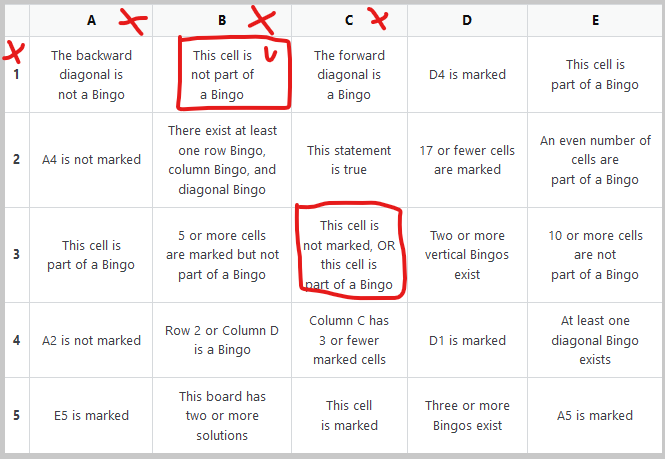To start off with:
1 and B are clearly not bingos, due to B1 (thus, B1 is marked). Similarly, C is not due to C4 and A is not due to A2 and A4 being mutually exclusive.
Notation: Marked cells have a rectangle. Cells which have been 'fulfilled' (either they're true, or they can't be true anymore for unmarked cells) have a sort of checkmark. Non-bingo rows/columns/diagonals have an X, bingo rows/columns/diagonals have an arrow.
Then,
C3 must be marked. If it isn't, the first statement is true and the second false, so due to the OR it must be marked. Hence, contradiction.
The next step is a bit harder.
Looking at D3 - if it's marked, both D and E are bingos. That also implies B4 and A5. We have 13 cells part of a bingo now, so we need at least one more, which will be a row. E2 means we will need at least 16 bingo cells - which rules out E3. Thus, D3 can't be marked.
C3 must be part of a bingo. If this is the forward diagonal, that means we have A1, C1, and D4 implies D1 as well. B2 implies E1 as well (due to the column bingo), which makes row 1 a bingo (which can't be). Thus, it must be the back diagonal. That implies E4, and rules out A1 and in turn C1. A5 also implies E5
Now we get some easier deductions:
B4 implies row 2 is a bingo, then B2 implies E is a bingo. A4 is also ruled out. We can also mark D5.
We can then look at C4 - if it's not marked, it must be true, so hence a contradiction. So C4 must be marked, C5 can't be. Also, A3 can be ruled out - there's no bingos it can be part of.
Last steps:
We have 15 marked cells. D1/D4 would imply B3 as well, so they can't be marked (because that would violate D2). E3 will be satisfied for sure, as will D2. Now, we have 3 cells marked but not part of a bingo. If B3 is marked, then so does B5 need to be marked to satisfy B3. But that violates B1. Thus, B3 is false. B5 can be both marked and unmarked for a solution - so it must be true? But that collapses it to just one solution, making it false...







